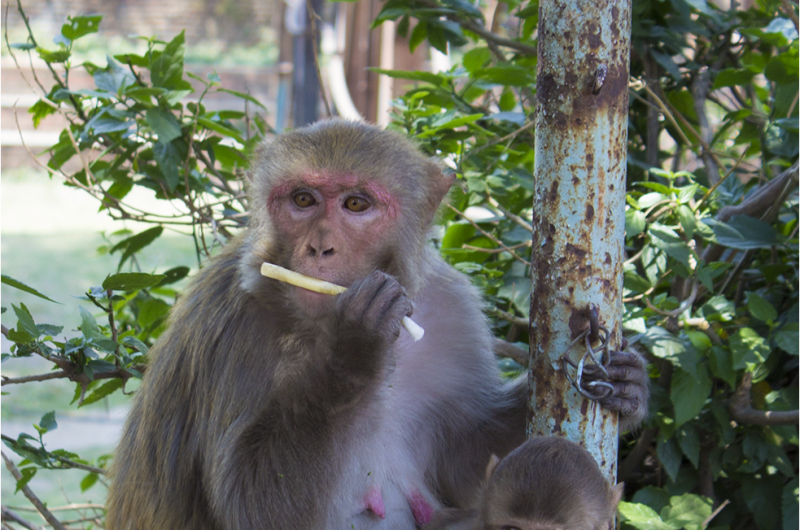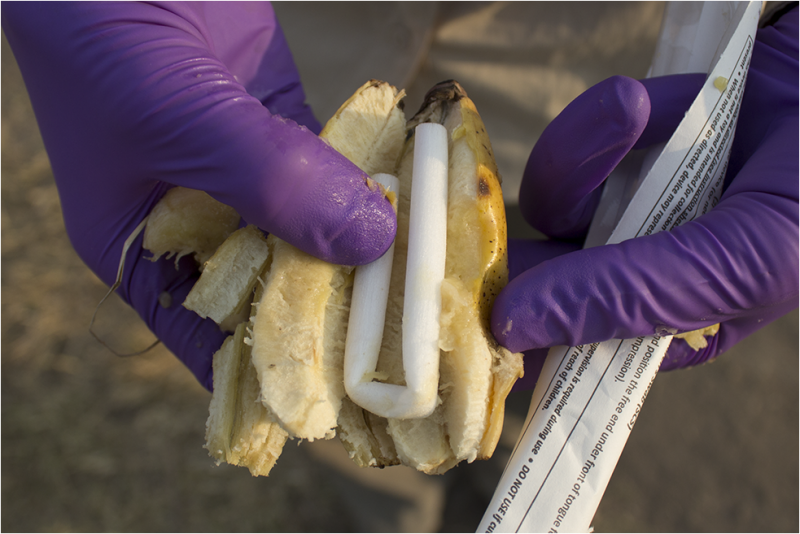Better surveillance and improved sampling tactics of wild animal populations could impact public health

What do Ebola, rabies and bovine tuberculosis have in common? The answer is that they are all zoonotic diseases, which are diseases that originate in one species and then spillover into another. The Centers for Disease Control estimates that six out of 10 infections that occur in humans first appeared in animals. In fact, diseases that we would commonly think of as specialized human diseases, such measles and HIV/AIDS, first originated in animals. Oftentimes, zoonotic disease outbreaks seem to practically appear out of nowhere. Monitoring the health of animals that live near humans and interact with humans is important. But while monitoring the health of domestic animals is easy—they are used to us and are more tolerant of our poking and prodding—sampling wild animal populations presents a challenge.
Increased interaction between humans and wild animals leads to more opportunities for infection
The spread of disease from animals to humans and vice versa is due to species interaction, which can happen a number of ways. When wild animal populations lose their habitat, they have no choice than to learn to live in close contact with humans. In the case of animals that are genetically quite similar to humans such as Old World Monkeys, which include baboons and macaques, diseases can adapt pretty quickly to flow between species, and they flow both ways. Human diseases can also infect animal populations, and it is important to monitor the health of the animals also to protect the biodiversity of the planet. A pathogen does not care who or what they infect, but rather pathogens are just looking for a host, and can evolve quickly.
Old World Monkeys are very intelligent creatures, and traditional sampling techniques to gather blood and saliva presents a host of problems. Collecting these types of samples often involves sedating the animals. These animals often evade researchers and will rarely let scientists collect a sample more than once, even if the scientist is able to subdue them. This causes a problem in these data; repeated sampling of these animals is necessary to get a full picture of disease trends and overall health of a population. On top of that, Old World Monkeys often teach their offspring and other members of their communities to avoid researchers. Because of the difficulty of field sedation and sampling the most common method for monitoring the health of these animals is the collection of excrement; but this method does not tell the whole story since many pathogens are transmitted through bodily fluid, such as saliva, blood etc.
Saliva from wild animals spreads disease
Wild animals bite and saliva is the perfect way to infect humans or other animals with disease. In the case of rabies, it is not transmitted by contact with blood, urine, or feces, it is transmitted orally with the saliva as it comes into contact with mucosal surfaces. Many diseases could be present in an animal that appears to be healthy, or asymptomatic, and that could be fatal when that same disease enters the human population. This represents an important public health issue.

PLOS NTDs article introduces an adapted approach
An article recently published in PLOS Neglected Tropical Diseases by Smiley Evans et al. details how a technique typically used in the United States to monitor the health of domestic pigs has been adapted to sampling primates. This non-invasive, interactive method actually involves the animals sampling themselves. First, the researchers introduce a rope that the animals could chew on. In most cases, the researchers threw a rope covered in strawberry jam to the animal, and allowed the animals to chew on it until it was voluntarily discarded. The rope was then collected for testing for any potential pathogens present in the animal's saliva. The goal of this study was to evaluate rope distribution technique and to evaluate the quality of the oral samples from the ropes by looking for both DNA and RNA viruses.
Viruses were chosen for this study because of their fragility in the environment, especially in tropical areas, and their susceptibility to handling as compared to bacteria. Optimizing this technique for RNA viruses is especially important because these types of viruses have a high mutation rate—which provides greater likelihood of the virus jumping to another species.
The researchers tested their method by evaluating rope samples collected from laboratory animals—which they could sample with traditional oral swabbing methods as well—and compared them to the ropes collected from wild animal populations. While the controlled oral swabbing method provided more complete data, the ropes also had evidence of DNA and RNA viruses that could be detected. The researchers caution that with any new technique additional experiments are warranted, but their work indicates that this method could be used for disease surveillance in free-range primates and potentially other wildlife species when traditional sampling techniques may not be feasible.
Better data on wild animal populations could give way to greater knowledge

Human and wild animal interaction will become more prevalent as animal habitats continue to be destroyed by human activity. Habitat loss is often caused by humans altering the environment, not just through the direct destruction of habitat, but also by pollution, and also change of ecological structure caused by climate change (but that's a different blog post). Loss of habitat means loss of wild animal food sources, which could lead to an increase in wild animal interactions with humans. More interactions between humans and wild animals raises the probability of pathogens jumping between the species. From a public health perspective, more crossover between humans and animals can increase the prevalence of diseases with an animal vector, including Ebola and the plague among others.
Places where these two communities intersect are prime locations for emerging zoonotic disease epidemics, and as seen by the 2013-2014 Ebola outbreak in West Africa, lack of surveillance and lack of preparation can lead to devastating consequences.
Understanding animal health is essential to protecting human health, and monitoring species that serve as vectors for zoonotic diseases can help researchers keep track of pathogens that humans could be exposed to, and study how these diseases are transmitted between species. Monitoring wild animal populations and gathering stronger baseline data is also important to knowing how these diseases may evolve in the future.
Beyond public health, wild animal populations can also serve as an indicator for shifts in the environment, because they can detect subtle changes humans may not be aware of yet. It helps to think of wild animals as the "canary in the coal mine". Interactive sampling techniques, something that does not stress or intimated the animals, is a process that could significantly enhance our understanding of the health of humans, wild animals and of our environment.
More information: Zoonoses Fact Sheet, World Health Organization. www.who.int/zoonoses/en/.
Animal Bites Fact Sheet, World Health Organization. www.who.int/mediacentre/factsheets/fs373/en/.
Primates, Smithsonian National Zoological Park, nationalzoo.si.edu/Animals/Primates/Facts/.
Zoonotic Diseases, Center for Disease Control Fact Sheet, www.cdc.gov/onehealth/zoonotic-diseases.html.
Center for Disease Control and Zoonotic Disease Facts, www.cdc.gov/about/facts/cdcfastfacts/zoonotic.html.
Non-human Primates, Virginia Department of Health, www.vdh.state.va.us/epidemiolo … nonhumanprimates.htm.
Smiley Evans et al., "Optimization of a Novel Non-invasive Oral Sampling Technique for Zoonotic Pathogen Surveillance in Nonhuman Primates," Published: June 5, 2015 DOI: 10.1371/journal.pntd.0003813
This story is republished courtesy of PLOS Blogs: blogs.plos.org.



















